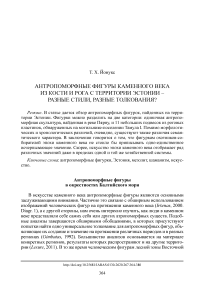Антропоморфные фигуры каменного века из кости и рога с территории Эстонии - разные стили, разные толкования?
Автор: Йонукс Т. Х.
Журнал: Краткие сообщения Института археологии @ksia-iaran
Статья в выпуске: 267, 2022 года.
Бесплатный доступ
В статье дается обзор антропоморфных фигурок, найденных на территории Эстонии. Фигурки можно разделить на две категории: единичная антропоморфная скульптура, найденная в реке Пярну, и 11 небольших подвесок из роговых пластинок, обнаруженных на могильнике-поселении Тамула I. Помимо морфологических и хронологических различий, очевидно, существуют также различия семантического характера. В заключении говорится о том, что фигуркам охотников-собирателей эпохи каменного века не стоило бы приписывать одно-единственное исчерпывающее значение. Скорее, искусство эпохи каменного века отображает ряд различных значений даже в пределах одной и той же хозяйственной системы.
Антропоморфные фигурки, эстония, мезолит, шаманизм, искусство
Короткий адрес: https://sciup.org/143179107
IDR: 143179107 | DOI: 10.25681/IARAS.0130-2620.267.364-380
Текст научной статьи Антропоморфные фигуры каменного века из кости и рога с территории Эстонии - разные стили, разные толкования?
В искусстве каменного века антропоморфные фигуры являются основными заслуживающими внимания. Частично это связано с обширным использованием изображений человеческих фигур на протяжении каменного века (Iršenas, 2000. Diagr. 1), а с другой стороны, нам очень интересно изучить, как люди в каменном веке представляли себе самих себя или других атропоморфных существ. Подобные анализы завершаются обширными обобщениями, в которых присутствуют попытки найти одно универсальное толкование для антропоморфных фигур, объясняющее их создание и значение на протяжении различных периодов и в разных регионах (Gimbutas, 1992). Большинство анализов основывается на материале конкретных регионов, результаты которых распространяют и на другие территории (Lesure, 2011). В то же время человеческим фигурам лесной зоны Восточной http://doi.org/10.25681/IARAS.0130-2620.267.364-380
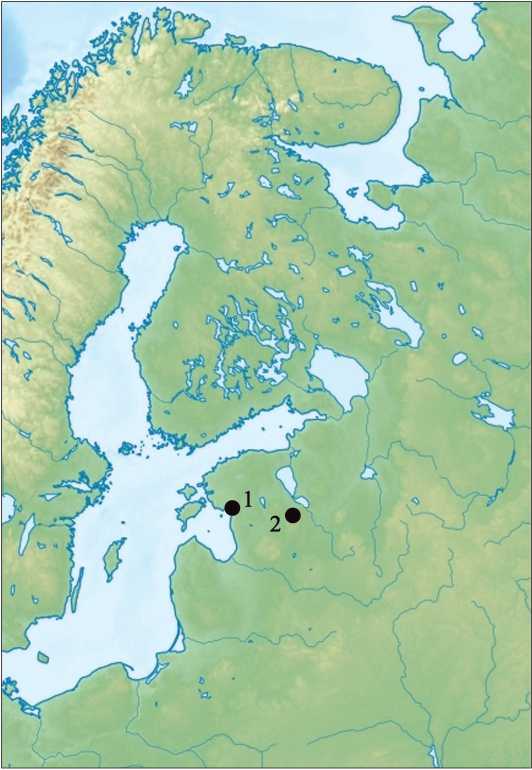
Рис. 1. Места находок роговых и костяных антропоморфных фигурок каменного века на территории Эстонии
1 – местонахождение на реке Пярну; 2 – поселение-могильник Тамула I
Европы было уделено меньше внимания ( Butrimas , 2000; Кашина , 2009). Большая часть материала лесной зоны Евразии не была включена в недавно изданный объемный справочник «Oxford Handbook of Prehistoric Figurines» ( Insoll , 2017).
В статье я рассмотрю костяные и роговые антропоморфные фигурки эпохи каменного века, найденные на территории современной Эстонии. В более широком контексте я рассмотрю их диахронически, уделяя внимание различным вариантам толкования фигур. Все примеры взяты из каменного века, который характеризовался промысловым хозяйством, а также, возможно, схожим общественным устройством и картиной мира. Переход общества с промысловым хозяйством к производящему хозяйству по большей части не являлся процессом, имеющим четкие границы. Особенно в обществах, проживающих в лесной зоне Севера Евразии, где климат не способствовал такому быстрому и эффективному переходу, оба способа ведения хозяйства существовали параллельно долгое время. Большинство рассматриваемых фигурок были найдены в Южной Эстонии, в могильнике возле поселения Тамула I (рис. 1: 2). Изотопные исследования скелетов позволили предположить, что основной пищей людей являлась пресноводная рыба, что указывает на промысловое хозяйство (Tõrv, 2018. Р. 127).
Начало искусства в Прибалтике зависит от того, что считать искусством. Старейшие примеры орнаментированных предметов датируются ранним мезолитом, однако примеры изобразительного искусства в регионе можно отнести приблизительно к VI тыс. до н. э. Именно к этому периоду относятся посохи с лосиной головой ( Iršenas , 2000; Kashina, Zhulnikov , 2011), а также антропоморфные скульптуры из могильника на Оленьем острове в Онежском озере. Древнейшие скульптурные изображения на территории Эстонии – фигуры птиц и человека из рога – также относятся к VI тыс. до н. э. ( Jonuks , 2013; 2016). Скульптурное искусство продолжилось в следующие тысячелетия, приблизительно в IV–III тыс. до н. э. к скульптурам добавились небольшие трехмерные фигуры в виде вырезанных из кости маленьких пластин-подвесок. На них были изображены как животные, птицы, так и люди, а область распространения таких подвесок охватывала Южную Финляндию, страны Балтии и северо-западную часть России. Отдельные подвески также были найдены в Швеции.
Антропоморфные фигуры с территории Эстонии
Найденные в Эстонии человеческие фигуры принадлежат к двум группам, имеющим разные хронологические и стилистические параметры. Эти различия, вероятно, указывают на разные нюансы, связанные со значением и способами использования.
Антропоморфные скульптуры из реки Пярну
Две антропоморфные фигурки были найдены на дне реки Пярну в первые десятилетия ХХ в. (рис. 1: 1 ). Одна из них исчезла во время Второй мировой войны, и сохранилась только ее газетная фотография низкого качества ( Jonuks , 2019). Со дна реки были собраны многочисленные костяные и роговые изделия каменного века и кости животных ( Jonuks , 2016). Когда река Пярну в VII тыс. до н. э. изменила свое русло из-за скопления отложений Литоринового моря ( Nirgi et al ., 2020), она затопила поселения, где под водой сохранились предметы из органики.
Скульптура размером 10 см вырезана из отростка рога (рис. 2). Тело отшлифовано, при помощи углублений обозначены подколенные впадины, талия и шея; грудь плоская, а острый разрез изображает линию подбородка. На теле не изображено ни одной детали, на лице при помощи впадины перед выступаю-
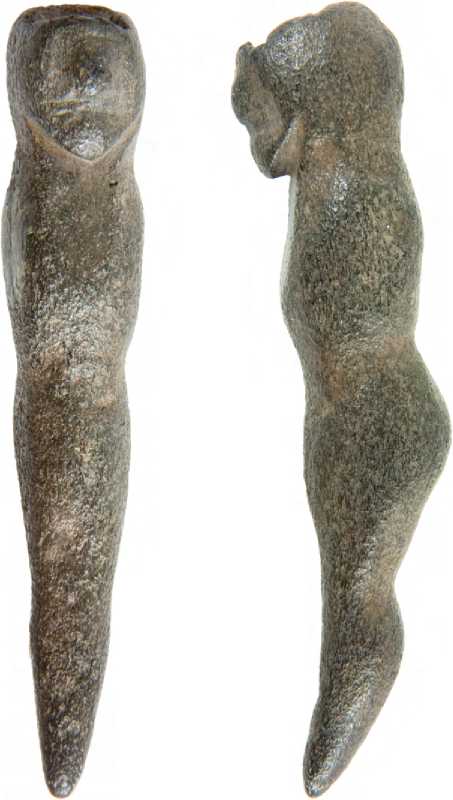
Рис. 2. Антропоморфная скульптура из реки Пярну щим подбородком показан рот, при помощи шлифования также имеется намек на нос. Четкие линии разрезов на туловище указывают, что фигурка закончена и ее простота и схематичность были целью автора.
Возраст скульптуры вызвал множество споров. Ее сопоставляли со стилизованными женскими фигурами Трипольской культуры ( Ebert , 1913. Р. 520; Childe , 1925. Р. 162; Ailio , 1922. Р. 108; Лозе , 1987. С. 39). Были попытки связать скуль-птурку с уже известными в то время керамическими фигурками эпохи финской культуры ямочно-гребенчатой керамики ( Glück , 1914. Р. 234; Leppäaho , 1937. Р. 41). Адомас Бутримас связал пярнускую фигурку с антропоморфной фигуркой из погребения 23 на Оленьем острове и датировал ее эпохой мезолита ( Butrimas ,
2000. Р. 10), а не неолита, как другие исследователи. Ее мезолитический возраст – около 6220–6020 гг. до н. э. – подтвердила дата пробы, взятой из головы фигуры ( Jonuks , 2016. Р. 117). Аналогичная дата – 6000–5840 гг. до н. э. – была получена и для роговой фигурки птицы со дна реки Пярну ( Jonuks , 2013).
Характерным признаком фигурки из Пярну является ее стилизованность и отсутствие деталей. У большинства изображений каменного века именно наличие конечностей или черт лица показывало, что речь идет о человеке. Изображение деталей на роге не было трудной задачей. Учитывая завершенность обработки, создается впечатление, что отсутствие изображения конечностей или четких деталей лица было намеренным и, очевидно, именно в этом следует искать способы ее толкования.
Отсутствие конечностей и изображение тела в виде плавных изгибов создает впечатление, что речь идет о человеке, чье тело чем-то покрыто или во что-то завернуто, вероятнее всего, в кожи, что указывает на мертвое тело, завернутое в кожи. Подобное предположение высказала Лив Нильссон Штутц ( Nilsson Stutz , 2006. Р. 232) при толковании фигур финской культуры ямочно-гребенчатой керамики, где также по причине отсутствия конечностей фигурки рассматривались как завернутые в кожу мертвые тела. Заворачивание в кожу часто присутствует в археологических толкованиях, связанных с погребениями, однако по большей части для этого нет достаточного количества доказательного материала ( Nilsson Stutz , 2003. Р. 296). В датских могильниках эпохи мезолита Skateholm I и II, Vedbæk-Bøgebakken на основании расположения костей удалось предположить, что мертвые тела были во что-то завернуты (Ibid. Р. 298).
Помимо того, что фигурка, вероятно, изображает завернутое тело, на то, что это мертвое тело, на мой взгляд, указывает лицо скульптурки. На ее лице обозначены сглаженный нос и рот, но нет глаз. Именно глаза являются основным признаком у большинства изображений человека в лесной зоне эпохи мезолита ( Iršenas , 2010. Р. 182). В глобальной перспективе прежде всего глаза являются основной чертой на лице, и они практически всегда присутствуют и «оживляют» образ ( Watson , 2011. Р. 95). Живые открытые глаза являются самой заметной частью лица, в то время как остекленевшие глаза мертвого человека являются характерным признаком мертвого тела, и в большинстве культур их пытаются скрыть, например, закрывая веки. В мезолитическом могильнике Звейние-ки на глазах погребенных найдены янтарные диски ( Zagorskis , 1987; Zagorska , 2008. Р. 122), а в Финляндии – диски из глины или сланца ( Edgren , 2006). Отсутствие у фигурки из Пярну глаз, а также невыразительное выражение лица могут служить подтверждением того, что речь идет о мертвом теле.
В Оленеостровском могильнике в погребении 23 найдена стилизованная фигурка (Гурина, 1956. С. 220, 221), очень похожая на скульптуру из Пярну. Она, правда, имеет две ноги, однако остальная часть тела также скрыта. Характерной особенностью этой фигуры являются два лица. На первом более четком изображены признаки человеческого лица – нос, рот, брови, обозначающие местоположение глаз. Безглазое лицо с другой стороны головы до крайности стилизовано. Возможно, здесь речь идет о попытке символическим образом изобразить человека, в котором присутствует как его живая, так и неживая сторона? В описаниях ритуалов, связанных с трансом, часто упоминается, что во время транса лицо человека меняется и глаза стекленеют. Возможно, что фигура из погребения 23 изображает кого-то в подобном состоянии и, следовательно, в этом человеке словно сочетаются признаки живого и мертвого существа или же несколько личностей? Такое толкование можно использовать для антропоморфной подвески из могильника-поселения Kretuonas IC в Литве, на которой с одной стороны изображен мужчина с бородой, а с другой – женщина или подросток (Butrimas, 2000. Р. 24).
Фигуры, изображающие мертвых предков, являются универсальными, они используются во многих религиях ( Insoll , 2011). Например, ханты хранили в своих домах скульптуры предков или домашних духов, которые должны были защищать деревню или семью. У них должны были быть глаза и уши, чтобы все видеть и слышать ( Jordan , 2003. Р. 170; Fig. 6: 13 ), что как раз и отличает эти скульптуры от найденной в Пярну фигурки, которая изображена подчеркнуто пассивной и мертвой, а следовательно, она не смогла бы выполнять защитную функцию. Значит, эта фигура изображает мертвого человека, который, очевидно, являлся членом сообщества, также можно предположить, что 8000 лет назад мертвым присваивалась совершенно другая агентность, чем в более поздних культурах.
Антропоморфные изображения из поселения-могильника Тамула I
Тамула I – поселение и крупнейший в Эстонии могильник каменного века с более чем 25 погребениями ( Tõrv , 2018). В торфяной почве Тамула сохранились предметы из органики, в т. ч. двенадцать антропоморфных изображений из костяных и роговых пластин. Эти изображения датируются на пару тысяч лет позднее, чем находка из Пярну, и выполнены в совершенно другом стиле.
Известны фрагменты шести фигур, изображающих человека целиком (рис. 3). Две из них из культурного слоя поселения найдены почти целыми (рис. 3: 2, 3 ). Обе они стилизованы, небольшого размера 3,5 и 6,5 см, имеют ровную заднюю поверхность. Фигурки похожи, статически изображают человека анфас, руки опираются на бедра. Деталей изображено мало, у обеих скульптур прослеживаются брови, указывающие на расположение глаз, одна фигура также имеет нос и рот (рис. 3: 2 ).
Третья найденная на поселении скульптурка высотой 4 см имеет наибольшее число деталей (рис. 3: 4 ). Перед нами человек с вытянутым лицом и бородой. Оба плеча и передняя часть украшены линиями, которые могут изображать одежду ( Indreko , 1931. Р. 34). Нижняя часть фигурки обломана. Ин-дреко реконструировал отсутствующую часть на основании фигур Юодкранте в виде костяной пластины с отверстиями ( Johanson et al ., 2013. Fig. 11), однако, на наш взгляд, у фигурки скорее было изображено человеческое тело, похожее на предыдущие.
Четвертая скульптура обнаружена в женском погребении X под головой вместе с костяной подвеской в виде птицы, подвесками из янтаря, клыков бобра и куницы, возможно, они крепились к головному убору. Фигурка состоит из трех фрагментов. Самая крупная ее часть изображает руки, опирающиеся на бедра,
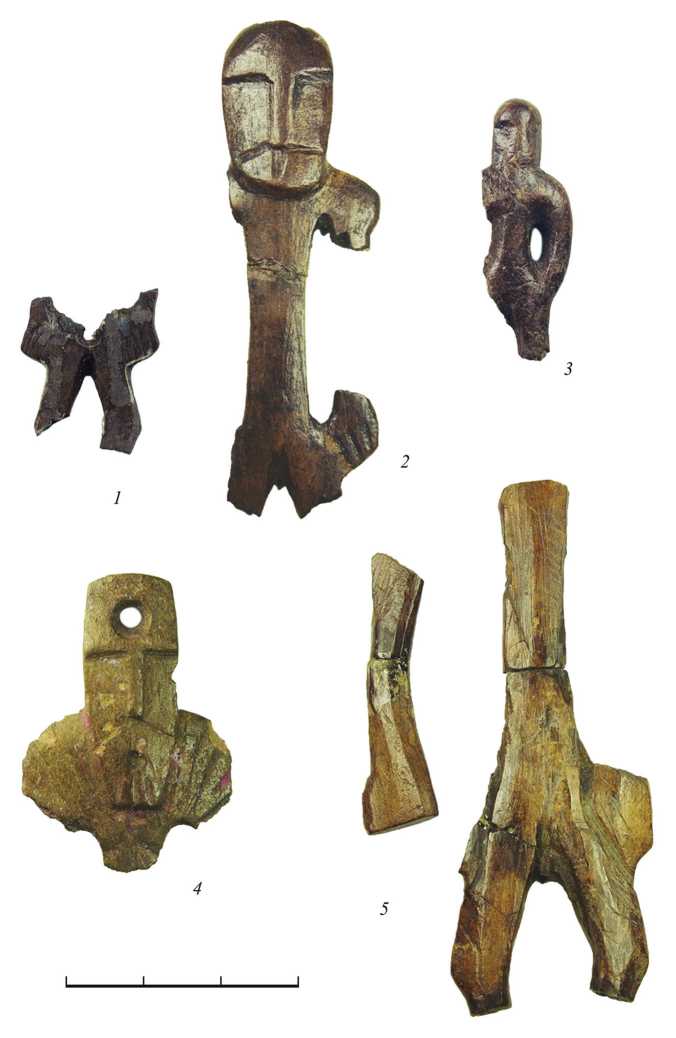
Рис. 3. Антропоморфные фигуры из поселения-могильника Тамула I и бедренную часть обеих ног (рис. 3: 1). В центре сделано отверстие для подвешивания. Погребение датировано 3620–2750 гг. до н. э. (Tõrv, 2018. Р. 135). Даты по другим погребениям также укладываются в этот временной промежуток. Поскольку все скульптурки из Тамула схожи, можно предположить все антро-, зоо- и орнитоморфные фигуры памятника относятся к IV–III тыс. до н. э.
Пятая и шестая человеческие фигурки найдены случайно, они изображают тело человека и его ноги до коленей (рис. 3: 5 ). Руки фигуры сломаны, но одна рука сохранилась как отдельный фрагмент, а местоположение второй демонстрирует кисть руки на бедре. Голова и ступни не сохранились.
Все эти фигурки похожи. Люди изображены анфас, стоя, в статической позе, руки опираются на бедра, ноги немного врозь. Им аналогичны и другие антропоморфные фигуры, обнаруженные в Прибалтике ( Butrimas , 2000; Кашина , 2009), которые отображают похожую культурную традицию и, очевидно, мировоззрение. Обломок плоской антропоморфной фигурки, напоминающей фигурки из Тамула, найден на поселении Бесов Нос VI на берегу Онежского озера ( Лобанова , 1995).
В Тамула также найдено шесть плоских изображений человеческих лиц (рис. 4). Аналогично предыдущим, они также очень однотипные, статичные и схематичные. Артефакты тщательно обработаны, для экспонирования предназначена лишь одна сторона. Все они закругленно-подтреугольной формы, глаза и рот выполнены в виде просверленных отверстий. Три личины выполнены более детально, на них изображены нос и брови. У трех оставшихся на человеческое лицо указывают только форма изделия и отверстия. Меньшее количество деталей может вызвать сомнение в антропоморфности предмета. То, что здесь показаны лица, подтверждается тем, что в погребении VIII найдено три таких предмета. Два из них четко изображают человека (рис. 4: 1, 3 ), а один не имеет носа и линии бровей (рис. 4: 2 ). Таким образом, эти предметы можно считать изображениями антропоморфных личин. Подвески из янтаря в форме трапеции, даже если на них не изображены глаза или другие элементы, считаются изображениями лиц. В этом случае важны схожая форма и орнамент предметов ( Indreko , 1957. Р. 77). Подвески с геометрическим орнаментом в форме трапеции ассоциируются с фигурой человека на Пиренейском полуострове, они считаются изображениями предков ( Lillios , 2003).
В отношении человеческих фигур каменного века Северной Европы многие исследователи отмечают правило иконографии, по которому человек изображается анфас, а животные в профиль ( Гурина , 1997. С. 121). Очевидно, что речь идет о проблемах передачи образа и его характерных признаков. Где можно, если речь идет о трехмерном материале, фигура изображалась трехмерной (рис. 5) ( Butrimas , 2000. Fig 36, 38). Многие исследователи связывают фигуры Тамула с янтарными фигурками Юодкранте из Литвы ( Jaanits , 1961. С. 36; Сту-дзицкая , 1985. С. 111). Костяные подвески в виде человеческих голов найдены в Литве в могильнике Kretuonas I C. В некоторых случаях в качестве материала использовался череп человека ( Butrimas , 2000). Фигурки стилизованы – на них изображены только наиболее важные детали, отмечены глаза, рот и нос при помощи вырезанных или просверленных отверстий, или же процарапанных линий. Только лишь на одной подвеске на лице можно предположить передачу эмоций, здесь изображен словно бы рот с зубами и злобное выражение, переданное
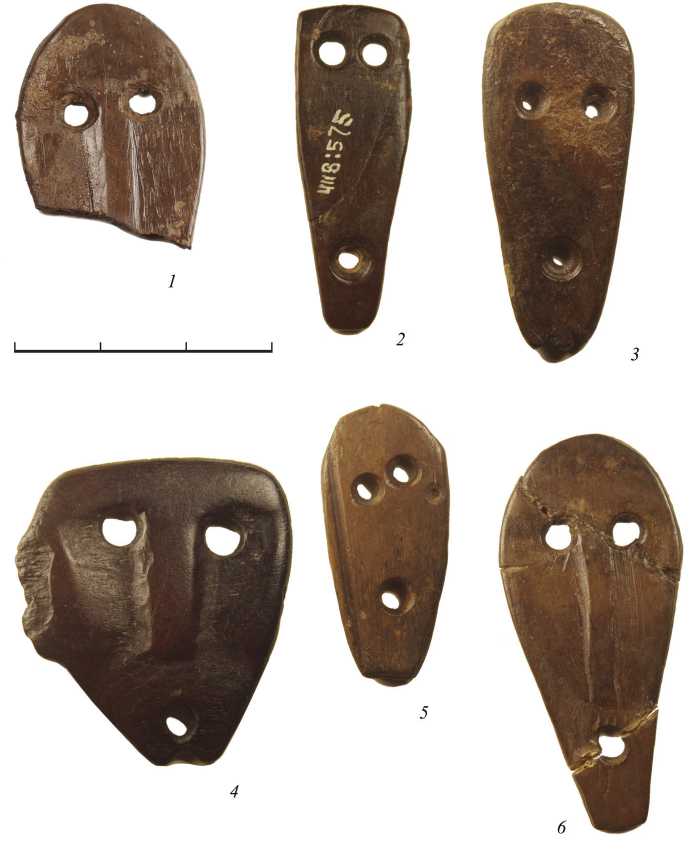
Рис. 4. Антропоморфные личины из поселения-могильника Тамула I при помощи диагональных линий на щеках (Butrimas, 2000. Р. 24). Похожие подвески в виде пластин найдены на поселении Бесов Нос VI на берегу Онежского озера (Лобанова, 1995), в могильнике Звейниеки (Butrimas, 2000), в Ниде в Литве, в Метсяпиртти в Карелии (Indreko, 1949; Werbart, 2007), на Кольском полуострове (Гурина, 1997; Butrimas, 2000; Кашина, 2009).
В центральной Швеции в могильнике-поселении Корснас была найдена костяная подвеска с просверленными отверстиями, указывающими на подмышки, похожая на скульптурки из Тамула, считается, что она предназначена для крепле-
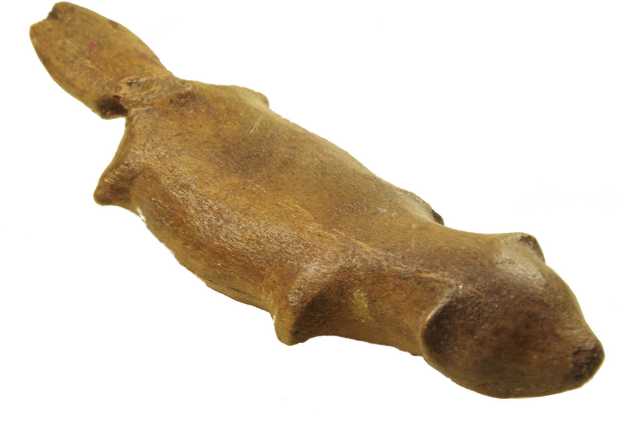
Рис. 5. Фигурка бобра из поселения-могильника Валма ния на мягкое основание (Olsson et al., 1994). Эта фигурка, вероятно, также изображала человека целиком, как и образцы с Тамула. Фигура из янтаря в виде головы человека была найдена в Альвареде, западная Швеция (Larsson, 2001. Р. 73).
Большинство фигурок из Тамула обнаружены в культурном слое поселения, где контекст неясен. Фигурки, связанные с погребениями, найденные в районе коленей (погребение VIII) (рис. 4: 1–3 ) и под головой (погребение X) (рис. 3: 1 ), очевидно, крепились к одежде. С учетом контекста находок, они, вероятно, не были свободно свисающими подвесками, а плотно крепились к головному убору (захоронение X) или к верхней одежде/элементу одежды наподобие фартука (захоронение VIII). Их задняя сторона не имеет отделки, что указывает на демонстрацию только лицевой стороны. Для крепления можно было использовать отверстия глаз или рта, но крепление из растительного волокна или кожаные шнурки можно было обматывать и вокруг фигурки. Фигурки с одним отверстием для крепления служили свободно свисающими подвесками. Поскольку антропоморфные подвески в погребениях лежат вместе с подвесками в форме животных или птиц, а также из зубов или клыков нет причин рассматривать их отдельно от остальных подвесок. Они все составляют единый комплекс, отображающий обширный пласт мировоззрения. Говоря о расположении подвесок (как в виде фигур, так и из зубов или клыков) на теле, можно сделать вывод, что по большей части они располагаются в районе головы, затем следует грудная клетка, конечности украшались реже. Подвески у головы чаще всего рассматриваются в качестве остатков украшения головного убора ( Jaanits , 1961; Gerhards et al ., 2003. Р. 559; Zagorska, Lõugas , 2000). Следует отметить, что район головы вообще является наиболее предпочтительным для помещения предметов, сюда же клали ножи, скребла и другие утилитарные вещи.
Интерпретация антропоморфных фигур
Значению подобных подвесок уделяется меньше внимания, чем их описаниям и проблемам датирования. В толковании по большей части проводятся аналогии с охотниками Северной Европы и их духовными верованиями. Большинство толкований связывает их с духовными предметами, целью которых является предоставление укрытия духам умерших предков ( Indreko , 1931; Jaanits , 1961). Согласно другому мнению, они представляют собой антропоморфных духов природы ( Гурина , 1997). Третья точка зрения связывает их с целительной магией ( Jaanits , 1961) с использованием в качестве аналогов кукол, обладающих волшебной целительной силой, например, в Удмуртии ( Popova , 2007). В последнем случае очень важным фактором являлось присваивание болезни фигурке, которую затем выбрасывали, а не носили с собой. В связи с этим фигурки, имеющие целительные свойства, изготавливались из простых, легкодоступных материалов, и на их отделку не обращали особого внимания. Человеческие фигуры эпохи каменного века в более широком смысле связывают с защитными амулетами, а также с защитной магией ( Butrimas , 2000). В археологической традиции стран Балтии сильную роль также играет археомифология ( Jonuks , 2011. С. 882), и фигурки эпохи камня рассматриваются в качестве мифологических. Бутримас рассматривает женскую фигурку с Т-образной головой, найденную в детском погребении в могильнике Звейниеки, как женщину-мать ( Butrimas , 2000), есть мнение, что костяные плоские подвески можно рассматривать в качестве мифологических существ, большинство из которых мужчины ( Студзицкая , 1985). Интересно утверждение Яанитса, что подобные подвески, найденные в Тамула, аналогичны фигурам духов-защитников, которые, по данным этнографии, являются частью ритуального костюма шаманов лесной зоны, также он предполагает, что подвески из Тамула в форме человека могли принадлежать местным ведьмам ( Jaanits , 1961). Многие исследователи толковали подвески и фигурки в качестве изображений шамана ( Werbart , 2007. Р. 222). Как правило, при этом без ответа остается следующий вопрос: для чего нужно было изображать шамана в виде фигуры и почему фигурку, изображающую шамана, хоронили в могиле вместе с мертвым телом?
Что касается стиля фигурных подвесок, по моему мнению, наиболее важным является факт, что они статичные, обезличенные и не изображают конкретных лиц, которых можно было показать через индивидуальные черты. Все фигуры максимально стилизованы, и передаются лишь наиболее важные детали, чтобы они лишь в общих чертах походили на изображаемый объект. Прежде всего, это касается фигурок людей. Стиль и уровень отделки фигурок животных отличаются, среди них встречаются как с прекрасной обработкой, так и стилизованные экземпляры ( Jonuks , 2009). Однако и у них, независимо от степени отделки, прослеживается, что животные изображаются в статичной позе. Статичность, стилизованность, обезличенность и способ использования подвесок – все это признаки того, что фигуры не конкретны, а скорее являются символами.
При истолковании объектов искусства следует учитывать временной и пространственный контексты их создания, а также мировоззрение и религию (Panofsky, 1972). Как видно из перечисленных выше вариантов толкований, религия каменного века в основном истолковывается на основании феноме-нов/явлений. Вместо системной религии и мировоззрения отдельным предметам присваиваются широкие и универсальные толкования, например защитная магия. В качестве религии в этих толкованиях, как правило, имеются ссылки на шаманизм как наиболее близкий аналог (Loorits, 1957. Р. 399). Шаманизм – это сложный религиозно-феноменологический комплекс, который используется по всему миру и в то же время по-разному толкуется в разных его частях (Price, 2001; Klein et al., 2002). Обстоятельство, которое позволяет связать фигурки эпохи каменного века с феноменом, аналогичным шаманизму, – это трактовка одухотворенного мира. Многие исследователи считают наиболее характерным признаком шаманизма экстатические ритуалы, для антропологического шаманизма в Евразии скорее характерно восприятие мира как одухотворенной среды (Paulson, 1958; Zvelebil, 2004). Подобный взгляд на мир в общем и целом создает предпосылки для появления шаманизма. Основной функцией шамана является общение с духами и воздействие на них наиболее благоприятным для его среды обитания образом (Hultkranz, 1978. С. 47). Шаман общается с миром духов, находясь в трансе и используя духов-помощников. Феномен духов-помощников – это фактор, который отличает шамана от других лиц, впадающих в транс, без них духовное путешествие шамана по разным мирам было бы невозможным (Eliade, 1972. P. 95). Фигуры духов-помощников как наиболее важных соратников шамана крепились к ритуальному наряду. Большая часть подвесок каменного века Северной Европы, обнаруженных в погребениях, очевидно, также прикреплялась к одежде. В антропологических описаниях часто упоминаются духи-помощники, которые крепились к ритуальной одежде или к барабану (Eliade, 1972; Graиeva, 1978; Djakonova, 1978; Dolgikh, 1978). На тех же основаниях Звелебил связывает фигурки людей и животных, подвески из бобровых резцов в мезолитических могильниках – с шаманизмом (Zvelebil, 2003; Кашина, 2009). Духи-помощники имеют разное происхождение (Eliade, 1972). Шаман может заполучить духов-помощников в период обучения или инициации, или же они могут перейти к нему по наследству (Gračeva, 1978. С. 318). В любом случае они связаны с шаманом лично, и шаман использует их в качестве спутников в своих духовных странствиях. Часто духами-помощниками являются животные, птицы или рыбы, реже – растения. Наиболее распространенными образами духов-помощников являются животные, которые объединяют в себе разные миры, – водоплавающие птицы, змеи, рыбы (Strassburg, 2000; Price, 2002; Lahelma, 2005) или бобры. Также ими могут быть души предков, которые помогают душе шамана перемещаться в сверхъестественных сферах (Eliade, 1972). Из антропологических описаний мы знаем, что шаманов хоронили вместе с их ритуальной одеждой, а ритуальные атрибуты закапывали близко от могилы (Kenin-Lopsan, 1978). Это можно объяснить тем, что духи-помощники, оставшиеся без присмотра шамана, могут причинить вред людям.
Может быть, поэтому многие подвески в захоронениях сломаны, и у них отсутствуют фрагменты. В ряде описаний духи-помощники умершего шамана считаются опасными, т. к. шаман, который мог их контролировать, умер (Mikhailova, 2006). Возможно, подвески, символизирующие духов-помощников, похороненные вместе с шаманом, были сломаны специально, чтобы их «умертвить». Это объяснило бы, почему не сохранилось ни одной целой антропоморфной подвески, а у большинства фигур птиц отсутствует голова. Если такие подвески позволяют связать погребения с шаманами, похороненными в своем ритуальном одеянии, то в этнографических примерах фигурки шамана не всегда клали в могилу вместе с ним. В Сибири цепочки и подвески снимали с одежды шамана после его смерти. Это считается причиной, по которой в захоронении предполагаемого шамана с оленьими рогами в Ведбек в Дании не было подвесок (Mikhailova, 2006).
Таким образом, можно связать подвески в изголовье в погребении X могильника Тамула с головным убором шамана, где они изображали духов-помощников. В качестве ритуального одеяния можно рассматривать расположение подвесок в захоронении VIII, где подвески из зубов отмечают рукава, а ряд плоских подвесок – нижний край одежды или фартука. Возможно, что эта одежда не была повседневной или «праздничной», а предназначалась для особых ситуаций, целью ее было удержать духов-помощников и дать обладателю одежды над ними власть. Такую ритуальную одежду, вероятно, носили редко, поэтому следы крепления и износа на подвесках могли не сформироваться.
Несомненно, не все фигурки каменного века можно считать изображениями духов-помощников. Среди находок, рассмотренных в статье, выделяются более крупные скульптуры, выполненные совсем в другом стиле.
Таким образом, в искусстве Балтийского моря видны две традиции. Более ранняя традиция создания объемных скульптурных изображений, датируемая приблизительно 6000 лет до н. э., куда входят антропоморфная фигура, найденная в Пярну, фигуры из Оленеостровского могильника и посохи с головой лося с восточного побережья Балтийского моря. Скульптуры имеют хорошую отделку, множество деталей и отличаются натурализмом. Что касается антропоморфных фигур, можно предположить, что в данном случае изображены лица с множеством личностей или же мертвые люди. Позднее, приблизительно 4000 лет до н. э., фиксируется традиция вырезания из костяных и роговых пластинок небольших фигурок, отделка которых на первый взгляд более небрежная. Обе традиции были утрачены приблизительно 2000 лет до н. э. В это время в странах Балтии началось постепенное освоение производящего хозяйства ( Крийска , 2009). Эти изменения не могли не повлиять на мировоззрение населения. В новую картину мира, вероятно, больше не вписывались изображения древних духов природы, что отразилось в изменении стиля искусства.
Список литературы Антропоморфные фигуры каменного века из кости и рога с территории Эстонии - разные стили, разные толкования?
- Гурина Н. Н., 1956. Оленеостровский могильник. М.; Л.: Изд-во АН СССР. 432 с. (МИА; № 47.)
- Гурина Н. Н., 1997. История культуры древнего населения Кольского полуострова. СПб.: Петербургское Востоковедение. 240 с.
- Kашина Е. А., 2009. Резные антропоморфные изображения неолита-энеолита лесной зоны Вoсточной Европы и Скандинавии // Верхнедонской археологический сборник. Вып. 4. Липецк: Изд-во Липецкого гос. пед. ун-та. C. 38–51.
- Крийска А., 2009. Некоторые вопросы возникновения земледелия в Восточной Прибалтике // ТАС. Вып. 7. Тверь: Триада. С. 39–48.
- Лобанова Н. В., 1995. О двух костяных изделиях из мезолитического слоя поселения Бесов Нос VI // Вестник Карельского краеведческого музея. Вып. 3. Петрозаводск: Полипринт. С. 19–22.
- Лозе И. А., 1987. Изображения человека в искусстве каменного века Восточной Прибалтики // Первобытное искусство. Антропоморфные изображения / Отв. ред. Р. С. Василевский. Новосибирск: Наука. C. 37–48.
- Студзицкая С. В., 1985. Изображение человека в мелкой пластике неолитических племен лесной зоны Европейской части СССР // Новые материалы по истории племен Восточной Европы в эпоху камня и бронзы / Отв. ред. Н. Я. Мерперт. М.: ГИМ. C. 100–118. (Труды ГИМ; вып. 60.) Ailio J., 1922. Fragen der Russischen Steinzeit. Helsinki: Suomen Muinaismuistoyhdistys. 110 p. (Suomen Muinaismuistoyhdistyksen Aikakauskirja; 29, 1.)
- Butrimas A., 2000. Human figurines in Eastern-Baltic Prehistoric art // Prehistoric Art in the Baltic Region / Ed. A. Butrimas. Vilnius: Academy of Fine Art. P. 7–29. (Acta Academiae Artium Vilnensis; 20.)
- Childe G. V., 1925. The Dawn of European Civilization. London: Paul Kegan. 320 p.
- Djakonova V. P., 1978. The vestments and paraphernalia of a Tuva shamaness // Shamanism in Siberia / Eds.: V. Diószegi, M. Hoppál. Budapest: Akadémiai Kiadó. P. 325–339.
- Dolgikh B. O., 1978. Nganasan shaman drums and costumes // Shamanism in Siberia / Eds.: V. Diószegi, M. Hoppál. Budapest: Akadémiai Kiadó. P. 341–351.
- Ebert M., 1913. Die baltischen Provinzen Kurland, Livland, Estland 1913 // Praehistorischen Zeitschrift. Vol. V. No. 3/4. S. 498–559.
- Edgren T., 2006. Kolmhaara reconsidered. Some new observations concerning the Neolithic burial practice in Finland // Back to the Origin: New Research in the Mesolithic-Neolithic Zvejnieki cemetery and environment, Northern Latvia / Eds.: L. Larsson, I. Zagorska. Stockholm: Almqvist & Wiksell International. P. 327–336.
- Eliade M., 1972. Shamanism. Archaic Techniques of Ecstasy. Princeton: Princeton University Press. 610 p.
- Gerhards G., Zarina G., Zagorska I., 2003. Burial traditions in the East Baltic Mesolithic // Mesolithic on the Move: Papers presented at the Sixth International Conference on the Mesolithic in Europe, Stockholm 2000 / Ed. L. Larsson et al. Oxford: Oxbow. P. 558–562.
- Gimbutas M., 1992. The Goddesses and Gods of Old Europe, 6500–3500 BC: myths and cult images. Berkely: University of California. 304 p.
- Glück E., 1914. Zusammenfassende Betrachtung der in den Jahren 1911 und 1912 erworbenen neolitischen Gegestände und die daraus gewonnenen Erkenntnisse // Sitzungsberichte der Altertumforschungen Gesellschaft zu Pernau. Vol. 7. Pernau: Laakman. P. 233–272.
- Gračeva G. N., 1978. A Nganasan shaman costume // Shamanism in Siberia / Eds.: V. Diószegi, M. Hoppál. Budapest: Akadémiai Kiadó. P. 315–323.
- Hultkrantz A., 1978. Ecological and phenomenological aspects of shamanism // Shamanism in Siberia / Eds.: V. Diószegi, M. Hoppál. Budapest: Akadémiai Kiadó. P. 27–58.
- Indreko R., 1931. Skulptuur ja ornament Eesti kiviaja luuriistades // Eesti Rahva Muuseumi Aastaraamat. Vol. VI (1930). Tartu. P. 47–70.
- Indreko R., 1949. Einige Bemerkungen über die Idole der kammkeramischen Kultur // Apophoreta Tartuensia. Societas litterarum Estonica in Svecia. Stockholm. P. 129–139.
- Indreko R., 1957. Die Idolanhänger–Amulette // Studia Neolithica in honorem Aarne Äyräpää. Helsinki: Suomen Muinaismuistoyhdistys. P. 61–79. (Suomen Muinaismuistoyhdistyksen Aikakauskirja; 58.)
- Insoll T., 2011. Ancestor Cults // Oxford Handbook of the Archaeology of Ritual and Religion / Ed. T. Insoll. Oxford: Oxford University Press. P. 1043–1058.
- Insoll T., 2017. The Oxford Handbook of Prehistoric Figurines / Ed. T. Insoll. Oxford: Oxford University Press. 960 p.
- Iršėnas M., 2000. Elk figurines in the Stone Age art of the Baltic Area // Prehistoric Art in the Baltic Region / Ed. A. Butrimas. Vilnius: Academy of Fine Art. P. 7–29. (Acta Academiae Artium Vilnensis; 20.)
- Iršėnas M., 2010. Anthropomorphic and zoomorphic Stone Age art in Lithuania and its archaeological cultural context // Archaeologia Baltica. Vol. 13. Klaipėda: Klaipėda University Press. P. 175–190.
- Jaanits L., 1961. Jooni kiviaja uskumustest // Religiooni ja ateismi ajaloost Eestis: Artiklite kogumik II. Tallinn: Eesti Riiklik Kirjastus. P. 5–70.
- Johanson K., Jonuks T., Kriiska A., Tõrv M., 2013. From the first people to idols and figurines: Richard Indrek oas a scientist // Man, his Time, Artefacts and Places: Collection of articles dedicated to Richard Indreko / Eds.: K. Johanson, M. Tõrv. Tartu: Tartu Ülikooli ajaloo ja arheoloogia Instituudi. P. 95–179. (Muinasaja teadus; vol. 19.)
- Jonuks T., 2009. Eesti muinasusund: Dissertationes archaeologicae Universitatis Tartuensis 2. Tartu. Jonuks T., 2011. The archaeology of Baltic religions // Oxford Handbook of the Archaeology of Ritual and Religion / Ed. T. Insoll. Oxford: Oxford University Press. P. 877–891.
- Jonuks T., 2013. An antler object from the Pärnu River – an axe, a god or a decoy? // Man, his Time, Artefacts and Places: Collection of articles dedicated to Richard Indreko / Eds.: K. Johanson, M. Tõrv. Tartu: Tartu Ülikooli ajaloo ja arheoloogia Instituudi. P. 225–246. (Muinasaja teadus; vol. 19.)
- Jonuks T., 2016. A Mesolithic human figurine from River Pärnu, South-West Estonia: a century-old puzzle of idols, goddesses and ancestral symbols // Estonian Journal of Archaeology. Vol. 20. No. 2. P. 111–127.
- Jonuks T., 2019. Mesolithic anthropomorphic sculptures from the Northern Europe // Quaternary International. Vol. 573. P. 104–112.
- Jordan P., 2003. Material culture and sacred landscape. The anthropology of the Siberian Khanty. Oxford: Altamira Press. 312 p.
- Kashina E., Zhulnikov A., 2011. Rods with elk heads: symbol in ritual context // Estonian Journal of Archaeology. Vol. 15. No. 1. P. 18–31.
- Kenin-Lopsan M. B., 1978. The funeral rites of Tuva shamans // Shamanism in Siberia / Eds.: V. Diószegi, M. Hoppál. Budapest: Akadémiai Kiadó. P. 291–298.
- Klein C. F., Guzmán E., Mandell E. C., Stanfield-Mazzi M., 2002. The role of shamanism in Mesoamerican art // Current Anthropology. Vol. 43. No. 3. P. 383–419.
- Lahelma A., 2005. Between the worlds: rock art, landscape and shamanism in Subneolithic Finland // Norwegian Archaeological Review. Vol. 38. Iss. 1. P. 29–47.
- Larsson L., 2001. The sun from the sea – amber in the Mesolithic and Neolithic of Southern Scandinavia // Baltic Amber / Ed. A. Butrimas. Vilnius: Vilniaus Dailes akademijos leidykla. P. 65–75. (Acta Academiae Artium Vilnensis; 22.)
- Leppäaho J., 1937. Pohjankurun «puujumalainen» // Suomen Museo. Vol. XLIII. Helsinki: Suomen Muinaismuistoyhdistys. P. 38–42.
- Lesure R. G., 2011. Interpreting Ancient Figurines. Context, Comparison, and Prehistoric Art. Cambridge: Cambridge University Press. 260 p.
- Lillios K. T., 2003. Creating memory in prehistory: the engraved slate plaques of Southwest Iberia // Archaeologies of Memory / Eds.: R. M. Van Dyke, S. E. Alcock. Blackwell Publishing. P. 126–150.
- Loorits O., 1957. Grundzüge des Estnischen Volksglaubens. Bd. 3. Heft. 1. Lund: Carl Blom. 691 p.
- (Skrifter Utgivna av Kungl. Gustav Adolfs Akademien för Folklivsforskning; 18, 3.)
- Mikhailova N., 2006. The cult of the deer and «shamans» in deer hunting society // Archaeologia Baltica. Vol. 7. Klaipėda: Klaipėda University Press. P. 187–198.
- Nilsson Stutz L., 2003. Death, Emotion and Identity in Late Mesolithic Cemeteries: Embodied Rituals and Ritualized Bodies: Tracing Ritual Practices in Late Mesolithic Burials. Lund: Almqvist & Wiksell International. 395 p. (Acta Archaeologica Lundensia; no. 46.)
- Nilsson Stutz L., 2006. Unwrapping the dead. Searching for evidence of wrappings in the mortuary practices at Zvejnieki // Back to the Origin: New Research in the Mesolithic-Neolithic Zvejnieki cemetery and environment, Northern Latvia / Eds.: L. Larsson, I. Zagorska. Stockholm: Almqvist & Wiksell International. P. 217–233.
- Nirgi T., Rosentau A., Habicht H.-L., Hang T., Jonuks T., Jõeleht A., Kihno K., Kriiska A., Mustasaar M., Risberg J., Suuroja S., Talviste P., Tõnisson H., 2020. Holocene relative shore-level changes and Stone Age palaeogeography of the Pärnu Bay area, eastern Baltic Sea // The Holocene. Vol. 30. Iss. 1. P. 37–52.
- Olsson E., Granath Z., Mohr A., 1994. Korsnäs. En gropkeramisk grav- och boplats på Södertörn. Stockholm: Riksantikvarieämbetet. 100 s. (Rapport; 63.)
- Panofsky E., 1972. Studies in iconology: humanistic themes in the art of the Renaissance. New York: Harper & Row. 260 p.
- Paulson I., 1958. Die Primitiven Seelenvorstellungen der Nord-Eurasischen Völker. Eine Religionsethnographische und Religionsphänomenologische Untersuchung // The Ethnographical Museum of Sweden. Stokholm: Statens etnografiska museum. 408 p. (Monograph Series; no. 5.)
- Popova E., 2007. Anthropomorphic figures in the Besermians’ modern treatment methods of illnesses // Medica IV. Ethnomedicine and Ethnobotany within Cultural Context and Everyday Life. International Colloquium: Abstracts / Ed. R. Sõukand. Tartu: Estonian Folklore Institute: Department of Folkloristics at the Estonian Literary Museum. P. 15.
- Price N. S., 2001. The Archaeology of Shamanism. London; New York: Taylor & Francis. 256 p.
- Price N. S., 2002. The Viking Way: Religion and War in Late Iron Age Scandinavia. Uppsala: Department of Archaeology and Ancient History, Uppsala University. 435 p. (Aun; 31.)
- Strassburg J., 2000. Shamanic Shadows. One Hundred Generations of Undead Subversion in Southern Scandinavia, 7,000–4,000 BC. Stockholm: Stockholm University. 462 p. (Studies in Archaeology; 20.)
- Tõrv M., 2018. Persistent Practices. A Multi-Disciplinary Study of Hunter-Gatherer Mortuary Remains from c. 6500–2600 cal. BC, Estonia. Hamburg: Wachholtz. 310 p. (Untersuchungen und Materialien zur Steinzeit in Schleswig-Holstein und im Ostseeraum; 9.)
- Watson B., 2011. The eyes have it: human perception and anthropomorphic faces in world rock art // Antiquity. Vol. 85. Iss. 327. P. 87–98.
- Werbart B., 2007. One sea, many landscapes and human interaction // Cultural Interaction between East and West. Archaeology, artefacts and human contacts in northern Europe. Stockholm University Studies in Archaeology. Vol. 44. Р. 218–224.
- Zagorska I., 2008. The Use of Ochre in Stone Age Burials of the East Baltic // The Materiality of Death: Bodies, Burials, Beliefs / Eds.: F. Fahlander, T. Oestigaard. Oxford: Archaeopress. P. 115–124. (BAR. International Series; 1768.)
- Zagorska I., Lõugas L., 2000. The tooth pendant head-dresses of Zvejnieki cemetery // Muinasaja teadus. Vol. 8. Tallinn. P. 223–244.
- Zagorskis F., 1987. Zvejnieku akmens laikmeta kapulauks. Riga: Zinātne. 132 p.
- Zvelebil M., 2003. People behind the lithics. Social life and social conditions of Mesolithic communities in temperate Europe // Peopling the Mesolithic in a Northern Environment / Eds.: L. Bevan, J. Moore. Oxford: Archaeopress. P. 1–26. (BAR International Series; 1157.)
- Zvelebil M., 2004. The Mesolithic of Eastern Europe // Ancient Europe 8000 B.C.–AD 1000. Encyclopedia of the Barbarian World. Vol. 1 / Eds.: P. Boovcki, P. J. Crabtree. New York: Charles Scribner’s Sons. P. 183–192.

